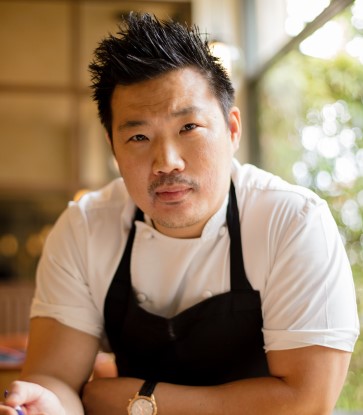“I need that one great idea, be it from ingredients to a dish, and I enjoy making my rendition of dishes that I see overseas when I am back in my kitchen at home,” he says.
Over the years, he has experimented with ways of “doing a different spin” on popiah, which is one of his favorite Singaporean foods. Lee is a frequent visitor to Singapore as he has been co-helming the MICHELIN Plate Chinese restaurant TungLok Heen at Resorts World Sentosa. In town to present a menu revamp last month, Lee, who sports his trademark ponytail, cuts a lean and trim figure with glowing sun-tanned complexion that belies his age.

Later this year, Lee plans to open more outlets of Kid Lee, a modern Chinese fast-casual eatery in Canada that he started with his two sons last year. He is also a consultant for the TungLok Group's first restaurant in Cambodia, which will open in October.
Here, we catch up with Lee and get his thoughts on the future of Chinese cuisine.
This menu revamp took six months as I am always looking for ways to improve the ingredients and presentation of the dishes. For the ginseng chicken soup, I topped it with Nepalese glutinous rice instead of the usual barley. I came across the rice on a sourcing trip with [TungLok’s chairman] Andrew Tjioe earlier this year and thought that the grain has a similar texture but lends a different touch to the soup.
Being trained in French cuisine, I love cooking with wine—especially Marsala—so I have wok-fried the sea cucumber with sherry in the soup. It is dry and sweet, which is almost similar to a good Shaoxing wine. Chinese stocks can be quite meaty, as we do not roast the bones like in European cuisine to bring out the flavors of the stock. So we rely on shallots and condiments, such as sherry to bring up the flavor of the stock.
How do you think Chinese cuisine can have a greater prominence on the global stage?
In recent years, there have been a couple of food guides and recognition platforms, which are integral in elevating the status and standards of the culinary world in China. There are great platforms to educate young chefs in Chinese cooking on topics such as ingredients from different parts of China, tea, service and sustainability. There is so much to embrace about the Chinese culinary world, from the wealth of audience, ingredients and talent.
What’s important is that young chefs need to have good mentors and a strong sense of initiative to learn. Gone are the days when you have to chop ingredients until you’re dead in order to master that skill. There is so much information that one can pick up from books and online portals and YouTube videos these days.

Not overcooking Chinese dishes, especially those with egg and seafood. Food needs to be about 70 to 80% cooked so that it is fully cooked when it arrives on the table. And most importantly, the dish has to be served hot. There is no point spending so much effort and time to garnish and plate the food when it has turned lukewarm. You need to be able to blow the heat away just before putting the food into your mouth. That’s what I love about eating Chinese food.
What are some of the evergreen skills that a Chinese chef needs?
Patience and integrity are still integral in shaping the values of a chef. Being a master in Chinese cooking means [having good knife skills], understanding ingredients, being a master of the wok and being skilled at not wasting ingredients.
What’s your advice for young Chinese chefs?
You need to have a strong love for food. Do not think about how long you need to be in the kitchen, but cook with patience and happiness and find out things by yourself. You need to get a little crazy and obsessed about something in order to truly master it.





















